American barbecue is more than a way of cooking. It’s myth, folklore, and history.
-
July/August 2020
Volume65Issue4
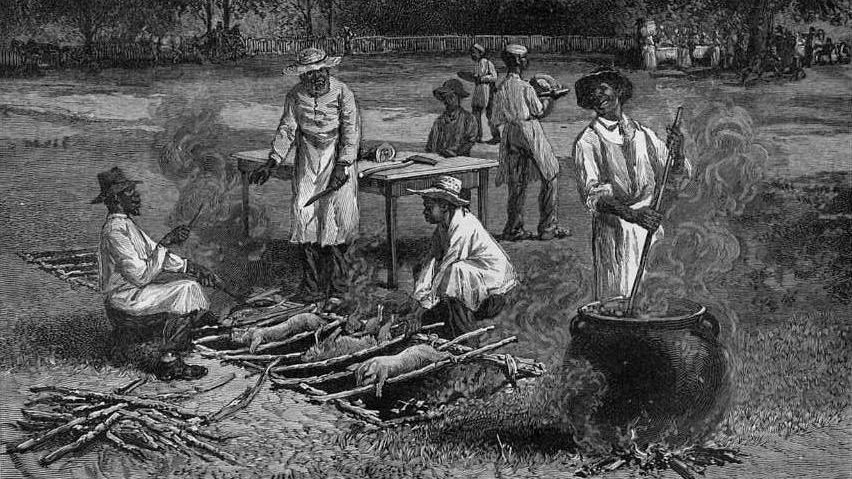
The Fourth of July and barbecue—and when we say barbecue we’re not talking hamburgers on a gas grill but traditional and delicious slow-pit-cooked pork, beef, and other meats—go together like… well, like Mom and apple pie. Except that apple pie came pretty directly from Europe and barbecue is as American as it gets: developed here, refined here, and enjoyed here, particularly on that quintessential American day of celebration—the Fourth of July.
Barbecue on the Fourth is an American tradition that goes back centuries. Millers Weekly Messenger reported a celebration on July 4, 1808, in what is now Oconee Station, South Carolina, where the local militia put on their Fourth of July parade and then, “a short address suited to the occasion was delivered by the Rev. Mr. ANDREW BROWN; after which they marched to an agreeable and natural arbor, where, in the company with a number of others, they partook of an elegant barbecue.”
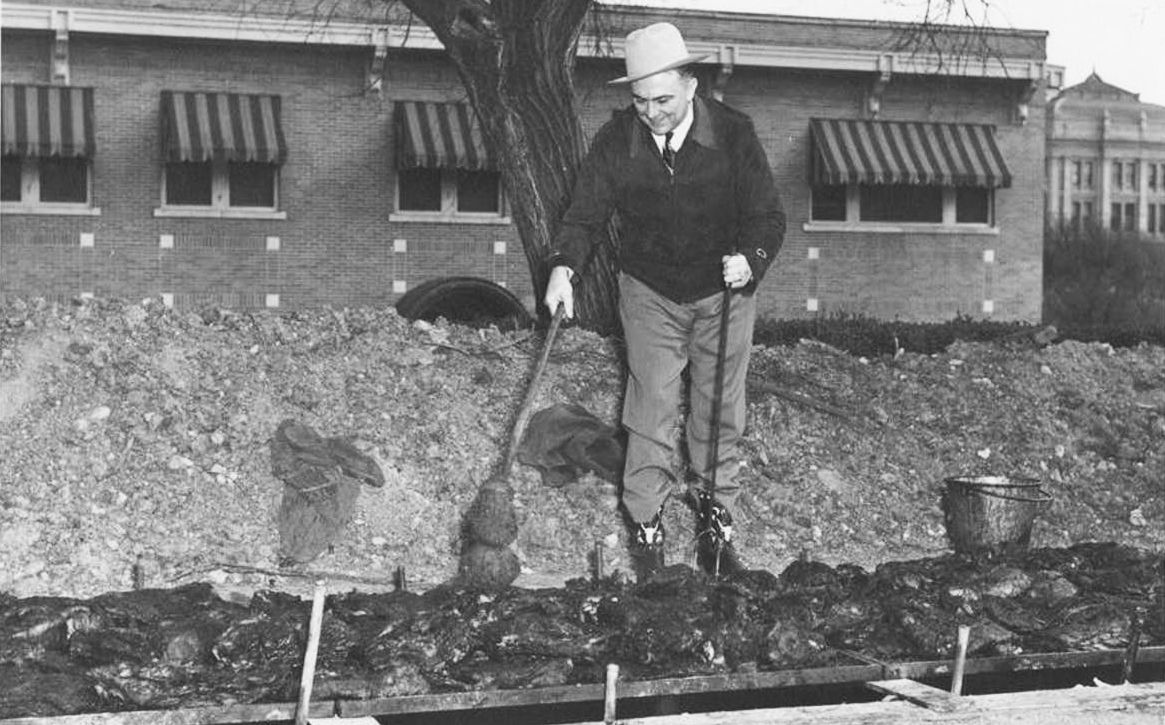
Famous naturalist John James Audubon attended a Fourth of July party in Kentucky in the early 1800s, and waxed a bit poetic about it: “As the youth of Kentucky lightly and gaily advanced toward the Barbecue, they resembled a procession of nymphs and disguised divinities…it served to remind every Kentuckian present of the glorious name, the patriotism, the courage, and the virtue of our immortal Washington.”
And let’s not forget Frog Bayou, Arkansas where, in 1846, according to the Arkansas Intellegencer: “The noble steer was immolated at this sacrifice—lambs, shoats, and poultry sent up their quotas to this patriotic feast.”
But it’s old-fashioned big business. No multinational chain can yet make good barbecue; you’ve apparently got to be an old-fashioned individualist, hardworking, innovative, and maybe more than just a little offbeat. Take Ed Mitchell, of Wilson, North Carolina. He barbecued a hog out back of his mother’s small store one day to cheer her up, and the next thing he knew his mother’s customers were asking for some of that good-smelling ’cue. He began cooking more and more hogs, and then he and an 80-year-old neighbor developed a custom brick barbecue pit with innovations that Ed will tell you make his barbecue not only better but easier and more convenient. Now Ed and his son run a restaurant focused on the history of barbecue in North Carolina, using heritage breed pigs raised by local farmers.
What is barbecue, real American barbecue? The answer depends on what part of the country you live in and who your parents were. It is one of the most intensely debated topics in American popular culture. At a restaurant in Galveston, Texas, I said to a couple at a nearby table, “Aren’t these ribs great!” “Well,” said the man, “they’re pretty good. Only there’s a place down in Florida where we’re from. Just a little shack.” He looked around and lowered his voice. “This stuff is okay. But back home, now, that’s what I’d call real barbecue.”
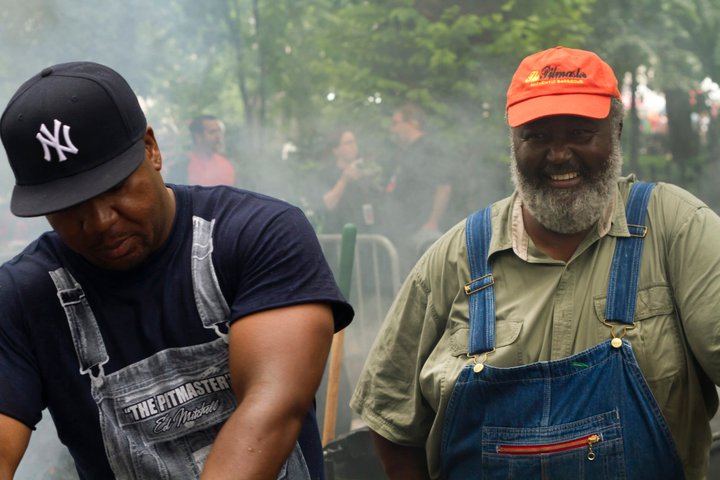
“Real barbecue” is what you keep hearing when you get talking to people about barbecue. Just what does it mean? There are many definitions. The easiest thing is to start by defining what it isn’t. First of all, it isn’t grilling. “You’re not flipping burgers or searing a steak. Instead you’re trying to turn a large, tough, gnarly cut of meat into something tender and succulent,” says one barbecue man I know. And second, barbecue certainly isn’t basting oven-baked chicken or ribs with “barbecue sauce,” the way Mom likes to do for Sunday dinner.
The hard part is to figure out what real barbecue is. The basic definition seems simple enough. It’s meat cooked over a framework, not on a spit, over a low bed of coals, not a brisk campfire, and slowly. It can take 12 hours or even longer, which is one reason barbecue pit masters often wake up very early. David Whitfield, a Mississippian hog cooker, says, “The key to cooking is to start slow, and don’t ever get much faster.” This accomplishes two things. It makes the meat tender and succulent, allowing the protein strands to stay long and supple as they cook and retain the meat’s juices, and it flavors the meat with the alchemical smoke from the coals. The result is addictive, delicious, and impossible to get any other way.
It sounds easy enough: barbecuing is slow cooking over coals. But once you start talking about what kind of meat to cook, over what kind of coals, for how long, and with how much smoke—and then throw in what kind of sauce, if any, you’re going to serve it with—well, the United States is a big country, and there are plenty of big opinions on each of these matters. And, of course, the controversy doesn’t stop there. From “What is barbecue?” you move on to another hotly debated topic, “Where did barbecue come from?”
Everyone agrees that natives of the Americas had a great deal to do with it. But what about African-Americans? And European-Americans? What contributions did they make? No one is really sure.
We do know that the Spanish conquistadors reported seeing Taino-Arawak and Carib natives in Hispaniola roasting, drying, and smoking meat (alligator, deer, and maybe even human) on wooden frameworks over small beds of coals. They called the framework a babracot, which the Spaniards turned into a barbacoa. The method appeared ludicrous to many early Europeans. Cooking over coals was not unusual, but over such low heat? An early French traveler noted incredulously: “A Caribbee has been known, on returning home from fishing fatigued and pressed with hunger, to have the patience to wait the roasting of a fish on a wooden grate fixed two feet above the ground, over a fire so small as sometimes to require the whole day to dress it.” Not coincidentally, perhaps, these peoples also invented the hammock, a good place to lounge while waiting for barbecue to get done.
The European arrivals found natives barbecuing in many parts of America, at least south of the not-yet-delineated Mason-Dixon Line. A Frenchman named Jacques Ie Moyne painted the Taino-Timucua of northern Florida cooking their meat and fish on a babracot in 1564. And a historian, Robert Beverley, commented in 1705 that the natives in Virginia had “two ways of Broyling viz. one by laying the Meat itself upon the Coals, the other by laying it upon Sticks rais’d upon Forks at some distance above the live Coals, which heats more gently, and drys up the Gravy; this they, and we also from them, call Barbacueing.”
The European colonists apparently took to this odd method of cooking with alacrity. By the end of the 1600s barbecuing parties had become so popular that Virginia had to enact a law prohibiting the celebratory shooting of firearms during them. As the meat cooked long and slow, guests danced and socialized or played outdoor games like horseshoes, with betting and liquid refreshment. Barbecuing was already not just a cooking method but a social event. George Washington mentions in his diaries attending barbecues a number of times, including a “Barbicue of my own giving at Accotinck” in 1773.
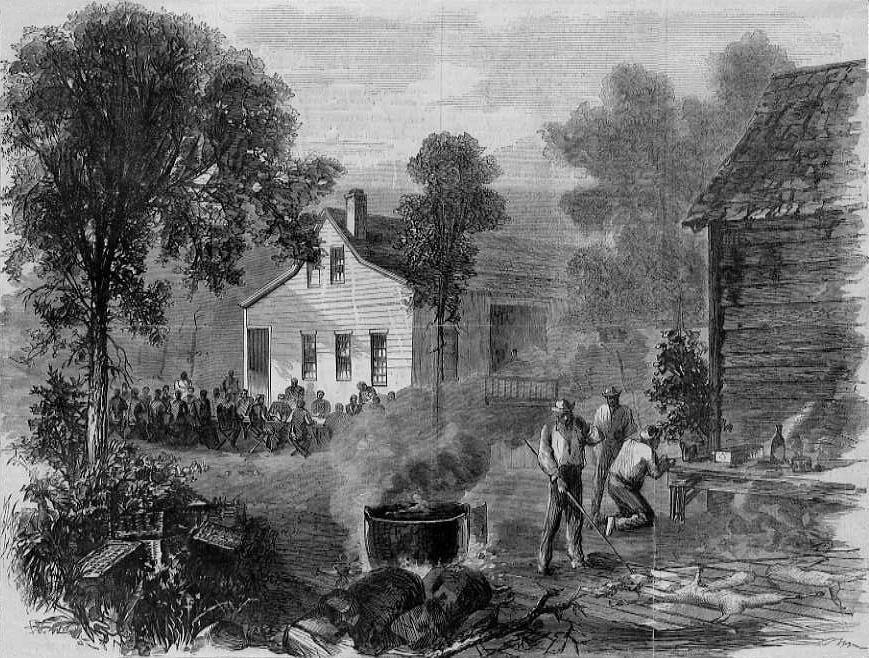
One of the frustrating things about these early colonial records is that they tell us virtually nothing about who was doing the barbecuing. Today the barbecue cook, or pit master, as he (usually it’s a he) is sometimes called, is a celebrity of sorts, respected for his arcane skill. Then it was a different matter. A popular assumption is that the first pit masters were enslaved people. However, while there undoubtedly were enslaved people cooking barbecue fairly early on, large-scale slavery did not gain a real foothold in the South until the late 1600s, by which time barbecuing was already commonplace.
It is very likely that enslaved people did the cooking at the well-heeled barbecues attended by George Washington in the late 1700s, but poorer whites probably did quite a bit of their own barbecuing. None of which is to deny African-Americans the enormous contributions they have made to American barbecue, but it seems reasonable to view barbecue as the ultimate representation of the American melting pot, created by Native Americans and transformed by different groups of Blacks and whites.
The role of women in barbecue is an interesting question. In the white world, barbecuing was and still is predominantly a men’s sport. Early American cookbooks were addressed to women, and they contained no recipes for barbecue. Mary Randolph included a recipe titled “To Barbecue Shote” (a young hog) in her famous 1824 The Virginia Housewife, but it was for baked pork with stuffing. This all-male tradition has continued up to today, with few exceptions. The North Carolina barbecue expert Bob Garner explains: “Barbecue is just one of those things that men like to do to stay up all night and drink.”
At first glance, the same holds true in African-American barbecue circles. In his book Smokestack Lightning, Lolis Elie quoted Amazing Grace Harris, a Kansas City barbecue cook, as saying somewhat bitterly, “I have to earn my respect; that’s what keeps me going. Most of the barbecue people are mens.” Yet Adrian Miller, while researching his forthcoming book Black Smoke: African American Adventures in Barbecue (University of North Carolina Press, 2021) found that Black women had been involved in barbecue for centuries. He even discovered one 19th century woman who bought her way out of slavery with the money she made cooking and selling ‘cue.
Like any sub-culture, barbecuing has its own jargon and its own fights between different factions, such as that between the log burners and gassers. According to the Society for the Preservation of Traditional Southern Barbecue, a virtual community of barbecue enthusiasts, a log burner is “one who makes barbecue by burning hardwoods down to coals for use as the source of heat and smoke”; a gasser is one who barbecues with gas. Real barbecue masters might forgive the back-yard enthusiast his bag of charcoal briquettes. But gas? Smokey Pitts, spokesman for the SPTSB, jeers, “Might as well put the meat in the kitchen oven and make a nice pork roast out of it. It sure as hell ain’t what I’d call barbecue!” Gassers beg to differ.
A discussion of the relative merits of open-pit and closed-pit barbecue can also get a dandy fight going among partisans. Basically, open-pit barbecue is what the original Tainos were doing. Closed-pit involves covered cookers and is practiced more in Texas and the West than elsewhere.
The ultimate closed pit is the smoker. The covered pit or smoker is where the smoke ring develops. That’s the telltale pink edge you find just inside a piece of meat. It forms as a result of a chemical reaction between smoke gases and meat pigment. In the Western end of the barbecue belt the smoke ring is a sure sign of genuine down-home barbecue. But log burners on the East Coast have a different opinion. Says one: “It might taste good, but it’s not what we’d call real barbecue.” The only conclusion a non-combatant outsider can draw is that there are a lot of real barbecues, most of them delicious and all of them with their own arcane methods, terms, and tastes.
“If you don’t use the whole pig, it’s not barbecue,” said the late, great Pete Jones, founder of the Skylight Inn, in Ayden, North Carolina, which has been serving up whole barbecued pigs for over 70 years. All along the flat coastal plain of the Carolinas, where English colonists were once dominant, whole-hog barbecue is the primary style. In eastern North Carolina the pig is cooked very simply and served with the plainest of sauces, vinegar seasoned with salt, pepper, and a little red pepper. At a pig pickin’, a whole-hog barbecue get-together, guests have the option of picking the meat off the bones themselves or having it pulled and chopped, or not, to be eaten on a plate or on a soft bun, topped with a little more sauce and some coleslaw.
In the Piedmont district of western North Carolina, whole hog gives way to pork shoulder as the meat of choice. Professor Gary Freeze of Catawba College finds a link between the immigration of Pennsylvania Germans into the Piedmont and the transition from whole-hog to shoulder barbecue.
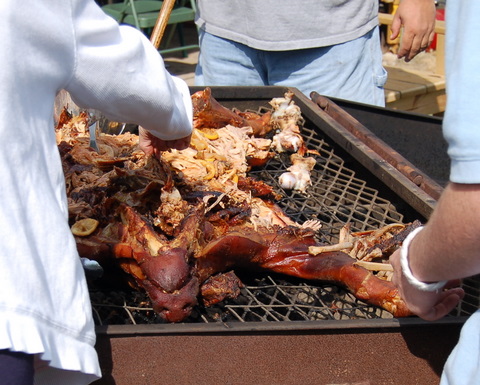
South Carolina cooks whole hog along the coast and shoulders and ribs elsewhere, but the state is known primarily for its unusual mustard-based sauce. Mississippi, Alabama, and Georgia all are securely within the pork belt as well, as is Tennessee. In these places whole-hog barbecue is found in rural areas. In the cities you’ll more likely find pork shoulders and ribs, along with more aggressive smoke flavors and tomato-based spicy sauces.
According to one Southern scholar, anyone foolish enough to barbecue anything besides pork puts himself “irrevocably outside the barbecue belt.” This option is ignored in Kentucky. Every May (except this year, of course), Owensboro holds an International Bar-B-Q Festival where “mutton gluttons” compete in a mutton-eating contest. Some believe Owensboro’s barbecued-mutton tradition began with the protection of sheep farmers under the Tariff of 1816. But the Kentucky and mutton connection predates that. A guest at the wedding dinner of Thomas Lincoln and Nancy Hanks, in Washington County, Kentucky, in 1806, recorded, “We had … a sheep … barbecued whole over coals of wood burned in a pit, and covered with green boughs to keep the juices in.”
Farther west they barbecue beef. Why? The obvious answer is that there are a lot of cattle in Texas, Oklahoma, Missouri, and Kansas. The question really should be how did barbecue get to these Western states at all? The Texas barbecue writer Robb Walsh believes that enslaved African-Americans, who made up 30 percent of the state’s population by 1860, brought barbecue with them from the South. When German and Czech immigrants got to Texas in the middle of the nineteenth century, they in turn brought a liking for sausage and brisket. Hot guts, as barbecued sausages are called, and smoky brisket became key to the Texas barbecue table.
Kansas City also barbecues beef, but when you get that far north and west of the original barbecue belt, traditional strictures go out the window and the natives go wild—just not necessarily hog wild. Carolyn Wells, executive director of the Kansas City Barbecue Society, says that in her town “if it moves, we cook it.” And they cook the beef, hogs, goats, lambs, ducks, chickens, turkeys, and fish any way they please, so long as it’s with plenty of smoke and lots of bright and brassy sauce, heavily laced with tomato and sugar. Kansas City is home to the world series of barbecue, which draws nearly 400 contestants and tens of thousands of spectators every year.
Fertile ground for food historians is the as yet unexplained fact that in some parts of the United States pit masters are primarily black men, while in others they are white. Robb Walsh says East Texas “is the only place where black Southern barbecue includes beef.” There is no doubt that the African-American connection with barbecue is strong. A barbecue was the celebratory reaction in Galveston, Texas, to the announcement on June 19, 1865 — two years after the Emancipation Proclamation — that slavery had been abolished in that state. Since then a barbecue picnic has been traditional with many Black Texans on Juneteenth. The great Black migration between the two world wars brought barbecue to the inner cities of the North and Far West. In nearly all these places the ’cue is mostly pork ribs and sausage, although in St. Louis there is an underground passion for barbecued hog noses, known affectionately as snoots. But folks there don’t talk to outsiders very much about that.
For years barbecue was the province of the rural and urban working class and poor, celebrated quietly by them at sociable back-yard get-togethers and in smoky roadside joints that weren’t always on the internet. The middle class occasionally participated in the “Barbecue Eucharist,” as one writer put it, at the annual church picnic or at political fundraisers. And from Sam Houston’s speech at the “Great American Barbecue” political rally for the American party in 1860 to LBJ’s famous cookouts, barbecue has always had a political tinge. You can’t campaign in the South without eating at barbecues. Sometimes political history is even made. South Carolina’s first integrated political event after Reconstruction was held at Gov. Donald Russell’s victory barbecue back in 1963. Even today Dixie Bones, a restaurant in Woodbridge, Virginia, caters political barbecue bashes for Southern members of Congress up in Washington — and provides different sauces for members from different states.
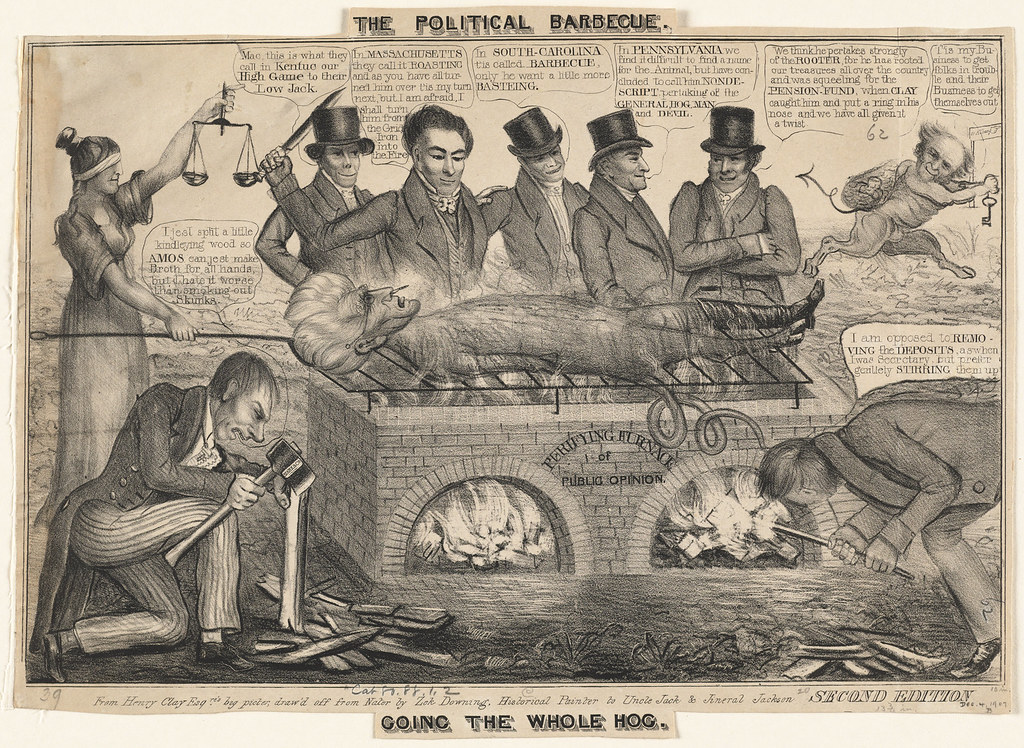
But it was only in the 1980s that barbecue really started going mainstream. That was when big barbecue contests began, pulling in thousands of middle-class Americans from every part of the country (although few contest participants are African-American). Also, books and cookbooks about barbecue started pouring out from publishers (notably, most are written by men). Upscale barbecue joints have opened across the United States, many of them fusion restaurants such as Heirloom Market BBQ in Atlanta, Georgia, that combines “Seoul” food and “Soul Food”, according to partners Jiyeon Lee and “Hillbilly” Cody Taylor. It’s what Adrian Miller calls “BBQ 2.0” — barbecue that references global flavors, particularly Tex-Mex and Asian flavors. Central Texas-style barbecue — beef, sausage, sauce on the side — is also in the forefront of American trends. That popularity is powered by the barbecue contests primarily attended by white men, and by Aaron Franklin in Austin, Texas, whose beef brisket and unassuming manner (along with praise from folks like Anthony Bourdain and institutions like Esquire) have catapulted him to much-televised fame.
Texas-style barbecue has even come to Canada. We recently went to Beach Hill Smokehouse “Authentic Texas Barbecue” in Toronto, Ontario. The owner, a tall Black Texan, served up juicy, smoky beef brisket and succulent smoked sausages with skins so tight they burst in our mouths like firecrackers. Outside, the Canadian snow was knee-deep. But inside, sitting at a rustic wooden picnic table dotted with rolls of brown paper towels, taking in the tantalizing aromas of smoke and meat, we were unmistakably and deliciously back home in the States.
Some purists fret that the introduction of fusion flavors, the focus on cooking to win contests, and the predominance of the Texas style threatens the existence of traditional barbecue. But where there’s smoke, there’s hope. And you’ve got to believe that anything people are this passionate about will survive, one way or another.
A few years back we went to Lexington Barbecue, in Lexington, North Carolina, where the founder, Wayne Monk, was quoted as saying, “As long as I’m the one making the decisions, we’ll continue to cook and serve our barbecue the way we always have.” The place was crowded — it serves about 1200 people a day — but that didn’t stop the waitresses from topping up my sweetened iced tea practically every time I took a sip. After a short wait, I got my tray of “outside meat,” hauntingly delicious dark and crusty slices of pork shoulder that had been cooking over hickory and oak charcoal for 12 hours. Monk’s son-in-law surveyed the bustling scene and mentioned that quite a few of the staff were younger family members who seemed interested in carrying on the family tradition.
“This is as good as it gets,” he said, with satisfaction. Whether he meant the busy restaurant or the barbecue or both, it didn’t really matter. He was right on all counts.

